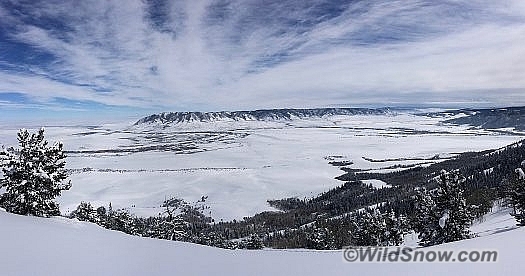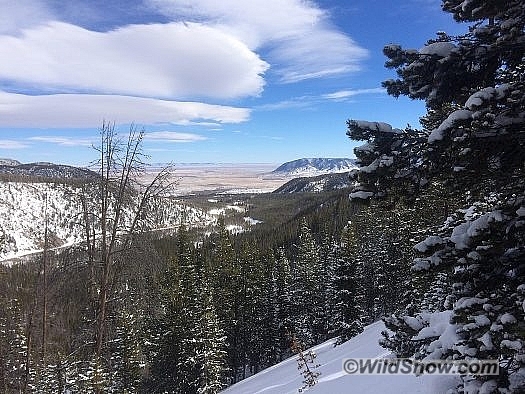This post sponsored by our publishing partner Cripple Creek Backcountry. They live in a place with snow capped peaks all around.
The road feels long and it feels flat and there’s nearly always a wind pulsing so incessantly it’ll make you think your tires stopped moving. It’s a lonely, loamy road, the only road that leads from the town of Laramie to the start of the Snowy Range in the Medicine Bow Mountains.
On an early January morning with the temperature somewhere around five degrees, my truck is the only one on the road. I spot scrawny pronghorn nibbling windswept prairie grass. The few houses I pass are miles apart, isolated dots on the plains with scrubby trees for meager windbreaks. Locals around here call the wind “population control” and as I feel it push against the truck I think, well, there’s something to that.
I came to Laramie from Colorado’s central Rockies in a move fraught with compromise. Days after receiving my acceptance letter for a fully funded masters program at the University of Wyoming, I sat in a hot spring with two close friends after a day of euphoric powder skiing and confessed, “Guys, I can’t go to grad school. I don’t think I can leave the mountains.”
“You’ve got to go,” counseled my friend, Steve, who’d been through grad school himself. “The mountains will always be here.”
The first winter on the high plains was destitute. The closest “good” skiing to Laramie is an hour and a half drive to Cameron Pass, Colorado. Beyond that, two hours to Rabbit Ears Pass, two and a half to Steamboat, two and a half to the eastern entrance to Rocky Mountain National Park, three hours to Silverthorne and the I-70 corridor, and the tallies go up from there. The Rockies this is not. No, the plains are very much the plains.
On subzero mornings during that first winter, I’d stand on the footbridge over the train yard downtown — one of the few spots in the flat valley where one can get a good view — and gaze to the distant summits of Cameron Pass, to the tip of Long’s Peak. I’d imagine myself sprouting wings and landing on skis on a snowy summit far from the Gem City’s austere expanses.
Eventually, though, I met some skiing folks, and then some more. The plains started giving away secrets, surprises. And by then, I was ready to see them.
* * *
Once I’ve passed the scrawny pronghorn antelope on that single digit morning, I drive through a breezy blink-and-miss-it town with four bars and maybe 200 year round residents. It’s rare enough to see a dog wandering the quarter-mile downtown drag in the morning, let alone a person. It’s about guaranteed to spot a few snow tornados though, spooling and unspooling across the asphalt.
Right smack on the western edge of town runs a north-south ridge and the first glimpse at something that looks like skiing: bald patches between the timber, some running the full 1,500 vertical feet from the treed ridgetop to the lodgepole and aspen aprons at the base of it. The runs are nicknamed by shape: Duck, Question Mark, Bear, Marge Simpson, Bart Simpson, Illinois, Yeti. The ridge is fickle though. With the ridgetop elevation just shy of 10,000 feet, it needs lots of snow and cold temps to cover the sagebrush. We haven’t had enough of that yet by mid-January, I keep driving.
After five winters on the plains, I’ve learned to see beyond them. To not focus on what’s missing in the vastness, but to focus on what is present. At a tight pull-off, I park the truck, stick skins on my skis, buckle my boots and head out to find it.
Three miles of cold skinning brings me into a drainage with old ski runs cut in the timber above. By the time I start climbing, my hair is frosted and my bindings squeak. The skin track winds through tidy lodgepoles and skinny aspen groves. Near the top I cross an old lift-line: a long snow ribbon wearing imprints of s-turns. It’s a favorite line for the few folks who ski out here. It’s steep, though, and I head to something more mellow: some sparse trees and a series of pillowy meadows I know to hold good snow.
The snow-filled spaces between the trees are untracked save for the lopsided prints of a snowshoe hare. I pull my skins and buckle my helmet. In the fifty years since this ski area was in operation, the forest has begun to reclaim it, dense branches and trunks crowd the run-outs. My helmet a piece of mind, if nothing else.
Dry January snow whispers as my skis slide through it. It’s deep and airy. A smile cracks the frosty skin on my face. Six sweeping turns later, I bust through tangled branches and pop out at the top of a meadow. The opening in the slope gives view to the Laramie Valley, a mostly flat expanse with so few features I feel I know each one intimately: the rounded bulge of Sheep Mountain, the pancake surface of Table Mountain, the crater-like depression of Big Hollow. I take a minute, take a breath, take it in.
In the years I’ve lived on the plains (far more than anticipated), I’ve hated them and I loved them. But in moments like this — a quiet still morning, skis and good snow underfoot, 600 feet of vertical to lap again and again — it doesn’t matter where I am. Whether I had to drive across wind-basted plains or I woke with snow capped peaks all around, skiing is skiing. I’ll take it.
(WildSnow guest blogger Manasseh Franklin is a writer and all around mountain enthusiast. She spends her weekdays teaching professional writing at the University of Wyoming and weekends finding her own inspiration in nearby backcountry.)
Manasseh Franklin is a writer, editor and big fan of walking uphill. She has an MFA in creative nonfiction and environment and natural resources from the University of Wyoming and especially enjoys writing about glaciers. Find her other work in Alpinist, Adventure Journal, Rock and Ice, Aspen Sojourner, AFAR, Trail Runner and Western Confluence.


